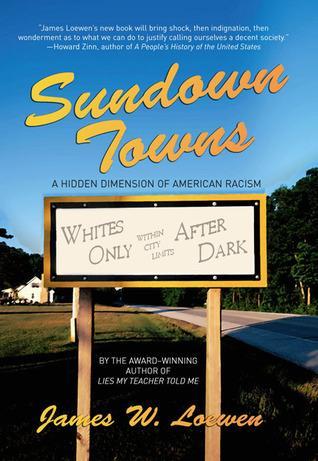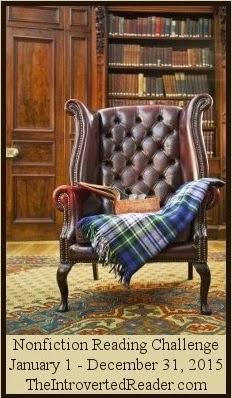Book: Sundown Towns : A Hidden Dimension of American Racism by James Loewen
Genre: Nonfiction
Publisher: The New Press
Publication date: 2005
Pages: 456
Source: Library
 The sign on the cover is a nicer version than most
The sign on the cover is a nicer version than mostSummary: First, a definition: Sundown towns are deliberately all-white towns and suburbs, historically delineated by a sign similar to the one on the cover of Sundown Towns (although, most often, much more rude in tone and wording) that forbids blacks in city limits after sunset.
After the Civil War, formerly enslaved Americans moved all over the US. It wasn’t until a generation later, during what is now called The Nadir of race relations (roughly 1890-1940), that towns and suburbs expelled their black populations — often by violence or the threat of violence.
Thoughts: One of the things that I learned from this book is that there are no naturally all-white towns or suburbs in America. No town is too far north, too rural, too rich, too anything to keep it from attracting African Americans residents if they were welcome. To believe that a town or suburb is naturally all white is denial. Here’s an observation by the author that demonstrates why it’s important to address that denial:
During the past 25 years, while teaching race relations to thousands of white people and discussing the subject with thousands more, I have found that white Americans expound about the alleged character and characteristics of African Americans in inverse proportion to their contact and experience with them. p. 320
This was a new thought for me: Sundown suburbs…
…try to keep out any problem or “problem group,” pawning off their own social problems on central cities and multi-racial, multiclass inner suburbs. Consider those members of society who are dramatically downwardly mobile — some alcoholics and drug addicts; some Down syndrome children; most criminals; people unhinged and impoverished by divorce; many schizophrenics; elderly people whose illness and incapacity have exhausted their resources and their relatives; employees fired when an industry downsizes and no one wants their skills. Every social class — even the most affluent — generates some of these people. Elite sundown suburbs offer no facilities to house, treat, or comfort such people…” p. 367
I was reminded of that quote while driving through one of the most affluent suburbs in my area. Yard signs declared objections to a proposal for senior and multi-family housing. Is that really good for the long-term stability of any community? When you look at property values, you might think so. But when you consider where you might end up when you’re no longer able to take care of yourself, you might come up with a different answer.
There is some hope at the end of this book, particularly the Gautreaux Project, a court-ordered program in Chicago in the late 1970s. Five thousand black families moved to more than a hundred previously white communities. It worked.
The achievements of the Gautreaux families augur that the quick eradication of sundown towns would foster the development not only of whites who are less racist, but also of blacks who are more successful. p. 357
Further resources: Besides the book, James Loewen maintains a website that includes a database of sundown towns — I found the town where my mother grew up and the one where one of my nephews was raised.
A recent episode of Fresh Air covered this topic as it applies to suburbs and cities, reiterating a point in Sundown Towns that the current inequality in wealth is directly related to housing restrictions — consciously and deliberately enforced by government policy.
 Appeal: Any one interested in how we became the America we are today will learn a lot from this book. This also proved to be an excellent book club selection. Even people who didn’t read the book were entranced by the topic.
Appeal: Any one interested in how we became the America we are today will learn a lot from this book. This also proved to be an excellent book club selection. Even people who didn’t read the book were entranced by the topic.
Challenges: Sundown Towns counts for three of my 2015 Challenges: the Nonfiction Reading Challenge, the Chunkster Reading Challenge, and Diversity on the Shelf.
Have you read this book? What did you think?

